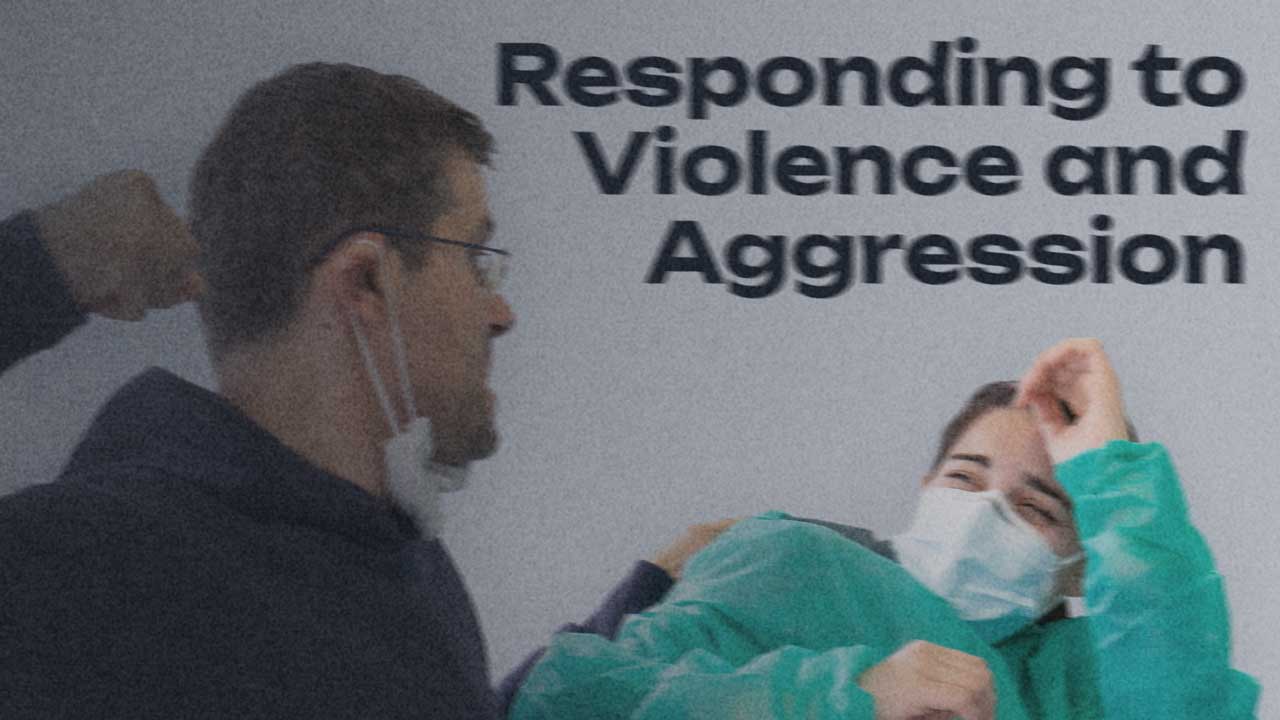No one should have to deal with aggression within the workplace, but healthcare professionals often do.
Violence towards healthcare workers is never OK, and there should be zero tolerance for it.
Violent incidents are more likely to involve emergency room staff and staff who are directly involved in patient care, especially nurses and paramedics (Lim et al. 2022).
According to Safe Work Australia (2024), healthcare and social assistance is one of the two industries with the highest rates of occupational violence, with around 95% of Australian healthcare workers estimated to have experienced physical or verbal violence (AMA 2024).
Violence in the workplace can have many negative effects on an individual. It can affect their physical health, as well as their psychological and emotional wellbeing, resulting in decreased motivation, and anxiety or depression (Safe Work Australia 2021).
There are different strategies that can be used to protect healthcare workers against occupational violence.
These approaches may be in the form of organisational policies such as codes, as well as training for workers who are at increased risk of experiencing some form of violence in their day-to-day work.
Using risk assessments to identify those at a higher likelihood of becoming aggressive or violent and ensuring a calm and supportive environment is provided for patients may be helpful in preventing violent and aggressive situations from occurring (Gaynes et al. 2016).
It’s also important to remember that certain illnesses can potentially cause a patient to become aggressive. These include but are not limited to:
- Hypoxia
- Cerebral insults such as seizures, meningitis or trauma
- Conditions causing cognitive impairment such as dementia and delirium
- Metabolic disturbances such as hypoglycaemia, electrolyte imbalances etc.
- Organ failure (e.g. liver or renal failure)
- Intoxication or withdrawal from substances
- Developmental disorders.
(ANZCOR 2020)

Responding to Aggression and Violence
If you are faced with an aggressive or threatening patient or visitor, here are some important points to consider:
Remember That Your Safety is the Number One Priority
It’s important to always consider your own safety. Call for help and remove yourself from the situation. If you’re interacting with a potentially violent person, make sure you have an unblocked exit route.
Call For Help
Generally, a Code Grey indicates increased patient agitation and unpredictable behaviour compromising safety, while a Code Black is called when a person poses a serious and imminent personal safety risk (Monash Health 2021).
Note: Code Grey is not a standardised Code in Australia; however, some healthcare organisations may use it. In Victoria, all public health services are required to have a Code Grey response. Always refer to your state or territory’s legislation and your organisation’s policies and procedures (Vic DoH 2017).
It’s always better to call a code early and cause a false alarm than to call it too late. A code that’s called late often makes the situation a lot harder to get under control again. If there is any doubt about your safety, it’s always safer to call for help early and then remain at a safe distance until that help arrives.
Treat Any Suspected or Identified Underlying Conditions
Any medical problems that leave the person as a danger to themselves or others need to be treated prior to treating the behavioural disturbance (Pitts & Schaller 2023).
Listen
Listen to the person. Active listening is an important component of the de-escalation process. The individual may be aggressive due to fear of their situation or even because they have lost control of the situation, so listening to them is an important element of the communication process. Remember that when you are listening, you should avoid giving opinions on issues that are beyond your control (Nursing Times 2016).
Acknowledge Their Anger
Make reflective comments and use the words that are spoken by the aggressive individual, but keep these comments brief. Don’t use statements that can be perceived as devaluing the person such as, ‘You shouldn’t be angry’. Instead, use statements like, ‘I can see you are angry’. This type of statement can also be a good opening to explore the person’s feelings, giving them a chance to speak about how they are feeling. When an individual has an opportunity to express their anger, it can often assist in lowering their level of anger, and therefore, decrease the risk of a violent outburst (Nursing Times 2016).
Don’t Speak Unnecessarily
Resist the temptation to fill silences with words… it can be hard! A good strategy to implement is if the silence feels uncomfortable, slowly count down from 10. By doing this, you will often find that the other person will break the silence (Nursing Times 2016).
Be Mindful of Body Language
Make sure you maintain eye contact that is appropriate for the individual and ensure your body language is open and relays both your interest and engagement to the person. For example, a slightly inclined head can show that you are interested and is a non-threatening posture (Nursing Times 2016).
Show Empathy
Paraphrasing what the person says to you demonstrates empathy to the patient, as it shows them that their concerns are being listened to and taken seriously. This can also be a strategy to ensure the information you are gathering from the patient is accurate (Nursing Times 2016).
After an Incident
Following any sort of incident that involves violence and aggression, it’s important that any staff involved in the situation attend a debriefing session and are followed up with to monitor their physical, psychological and emotional wellbeing. It’s also important that the incident is reported to ensure accurate data collection and quality improvement (Nursing Times 2016; Vic DoH 2017).
Test Your Knowledge
Question 1 of 3
Which one of the following statements reflects appropriate communication in an aggressive situation?
Topics
Further your knowledge
 Free
Free

References
- Australian Medical Association 2024, ‘Measures Needed to Tackle Rising Threat of Violence Against Doctors’, AMA Media Centre, 19 November, viewed 2 December 2024, https://www.ama.com.au/media/measures-needed-tackle-rising-threat-violence-against-doctors
- Australian and New Zealand Committee on Resuscitation 2020, Guideline 9.2.11 – First Aid Management of The Agitated Person, ANZCOR, viewed 2 December 2024, https://www.anzcor.org/home/new-guideline-page-2/guideline-9-2-11-first-aid-management-of-the-agitated-person/
- Gaynes, BN, Brown, C & Lux, LJ 2016, ‘Strategies To De-escalate Aggressive Behavior in Psychiatric Patients’, Comparative Effectiveness Reviews, no. 180, viewed 2 December 2024, https://www.ncbi.nlm.nih.gov/books/NBK379388/
- Lim, CL, Jeffree, MS, Saupin, SS et al. 2022, ‘Workplace Violence in Healthcare Settings: The Risk Factors, Implications and Collaborative Preventive Measures’, Ann Med Surg (Lond)., viewed 2 December 2024, https://pmc.ncbi.nlm.nih.gov/articles/PMC9206999/
- Monash Health 2021, Emergency Code Booklet, Monash Health, viewed 2 December 2024, https://coronavirus.monashhealth.org/wp-content/uploads/2021/11/Emergency-Code-Booklet-2021_Digital-1.pdf
- Nursing Times 2016, ‘De-escalating Anger: A New Model for Practice’, Nursing Times, 25 July, viewed 2 December 2024, https://www.nursingtimes.net/mental-health/de-escalating-anger-a-new-model-for-practice-25-07-2016/
- Pitts, E & Schaller, DJ 2023, ‘Violent Patients’, StatPearls, viewed 2 December 2024, https://www.ncbi.nlm.nih.gov/books/NBK537281/
- Safe Work Australia 2021, Workplace Violence and Aggression, Australian Government, viewed 2 December 2024, https://www.safeworkaustralia.gov.au/safety-topic/hazards/workplace-violence-and-aggression/overview
- Safe Work Australia 2024, Workplace and Work-related Violence and Aggression in Australia Report, Australian Government, viewed 2 December 2024, https://data.safeworkaustralia.gov.au/report/work-related-violence-aggression-australia
- Victoria Department of Health 2017, Code Grey Standards, Victoria State Government, viewed 2 December 2024, https://www.health.vic.gov.au/worker-health-wellbeing/code-grey-and-code-black
 New
New 
